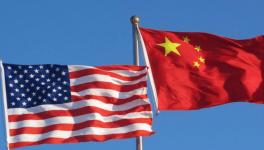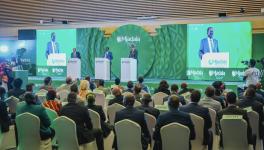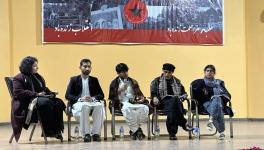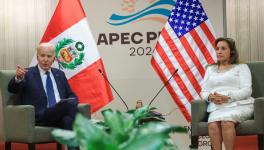West Reneging on the Promises Made to BRICS Countries During 2008 Crisis
In July, the BRICS countries – China, Russia, Brazil, India and South Africa – have set up the New Development Bank with the purpose of providing loans to poor countries across the world. A major feature of the new bank is that it will allow the BRICS to reduce their dependence on the US dollar. Both, the NDB and AIIB were set up for providing an alternate means of infrastructure finance because the demand for it in the developing world is huge. The AIIB has already approved four major loans for this purpose, in Asia.
The World Bank and the IMF tend to attach often unacceptably harsh conditions to the funding they provide. The IMF does not ask for collateral when it lends money to troubled countries; instead it prescribes economic policies that the country must follow. Unlike the World Bank, which assigns votes based on capital share, in the NDB each participant country will be assigned one vote and none of the countries will have veto power.
While, NDB and AIIB’s focus has been mainly on the infrastructure and sustainable development projects, they do not really challenge the Global hegemony that IMF presides over. But, this is the important challenge which is these BRICS banks will need to address.
Rough Transcript :
Prabir: Hello and welcome to Newsclick ,this program with Real News. We have with us former Managing Director General of ADB Rajat Nag and will discuss the BRICS summit. Rajat the BRICS Bank and the Asia Infrastructural Bank were supposed to be challenges to the IMF and the World Bank particularly the Asia Infrastructural Bank was supposed to fund a lot of infrastructural projects which otherwise the World Bank was funding and this was also supposed to put forward a different economic model of how infrastructure should be developed. Do you think it has made a change or do you think it is exactly following the World Bank pattern?
Rajat: I think that the AIIB or the NDB were formed for very different reasons than the one you mentioned. It is true that one could argue that they were there to provide additional funding for infrastructure and different funding etc. But the fundamental reason was that the governance of the Bretton Woods Institutions was totally out of sync with the reality. With the emerging economies now much more important, much more powerful than the reflection they had at the Bretton Woods institutions.
Prabir: The Bretton Woods Institutions the voting was essentially in the hands of the older economies.
Rajat: Exactly. And for example Belgium or Luxembourg had a higher voting percentage in IMF than Brazil.
Prabir: Luxembourg? That’s almost a state..
Rajat: Principality. Though to be fair the IMF was trying some reforms and the World Bank was trying some reforms and some reforms have happened but basically, countries like China, India were not given due place at the table. So the formation of the BRICS Bank or the formation of BRICS for that matter or AIB is basically a statement by the emerging economies that look if you are not going to give us a place at the table then we will not only create our own table we will actually create our own kitchen. So the AIIB the Asian Infrastructural Investment Bank was really a reflection of China’s understandable growing impatience with the existing institutions such as the World Bank or the IMF. The NDB or the BRICS Bank was essentially a reflection of that, that China, India, Brazil, Russia, they had very little in common but they certainly had a common focus, that they were not getting the due they deserved or they felt they deserved at the Bretton Woods Institution including ,I would say at the regional institutions such as the Asian Development Bank. So that was the reason they were set up. But it is also true that it was expected the AIIB and the NDB would fund infrastructure in Asia for NDB’s case and also for AIIB’s case because the demand for infrastructure is huge. To that extent, I think those institutions, it’s too early to tell, certainly AIIB has already approved four loans for infrastructure in Asia. They are following essentially similar principles of due diligence , environmental safeguards, social safeguards as the Asian Development Bank, the World Bank but since they are new they are probably a bit more nimble.
Prabir: Two other issues that come up. One is the terms on which they borrow, do they actually end up by shoring up the dollar as the global reserve currency? Is it going to make a change in that? That is one set of questions. The other is China has a lot of money , essentially reserves using that to expand the infrastructure was also argued that it’s a means of expanding the Chinese reach outside their countries and of their companies outside their countries. Do you think there is an element of truth in it?
Rajat: I think there is certainly definitely an element of truth in that. Again taking a slightly larger picture stepping back, China has very assiduously pursued in recent years this one belt, one road philosophy. It depends on who you talk to. If you talk to people in China they would argue one belt, one road, by the way now one dropped and now belt road is not a way to encircle Asia but it’s really a manifestation of greater regional co-operation, greater connectivity etc.
Prabir: I would like to add one element to this which is not commonly known that today 90% of global trade is maritime trade. If you take three hundred years back most of the global trade in the Eurasian landmass was really road, essentially land trade. In a certain sense it is trying to reverse the global dominance of what I would call the maritime powers which came up with the seventeenth, eighteenth, nineteenth century colonial powers…
Rajat: That’s right. So what China has cleverly done is talked about the maritime route as well. The belt is really the sea belt and the road is the old silk road which they are trying to put it on the…
Prabir: But still centered round the Eurasian landmass being stretched to Africa.
Rajat: Africa and to Europe on the west. But the Chinese then not only put this framework in place they actually put money behind it i.e. they put the AIIB in place. And the AIIB though it is definitely a multi-lateral institution, it now has more than forty member countries, it will expand to about sixty in the next few years, I am sure. Canada is the most recent country to have applied to join AIIB, the first North American country. But the AIIB is definitely a means for China in a multilateral setting to finance infrastructure.
The BRICS bank set up by the BRICS countries was also done for that purpose. But I have to say the rationale and raison d’etre for the BRICS bank suddenly seemed to have got a bit diluted if not confused by the arrival of the AIIB. Now one or the other certainly made sense. The BRICS bank I think has more of a challenge. Who does it lend to? It has lent to Russia for example. Does Russia need funding from another institution for infrastructure development issues needs to be discussed. But AIIB certainly has a much clearer mandate. Infrastructure in Asia of which there is a huge need and even when the Asian Development Bank and the World Bank put in a lot of money for infrastructure in Asia still the needs are huge and on top of that AIIB will obviously be able to mobilize funds from its owners, plus in the International Capital market. So there is a much larger game plan that China is putting in place.
Prabir: So AIIB is also connected to the belt rolling initiative as you were saying and the fact that Asia needs infrastructure and funding for that, ADB alone or other financial institutions are not enough and China has surplus reserves at the moment that it can use. But the other challenge which perhaps the BRICS Bank would have played a bigger role was the essentially the financial structure of the world in which IMF still sets the sort of shall we say the basic policies in place .And the dollar is the underpinning of global currency. Do you see that the BRICS Bank could in any sense challenge that?
Rajat: No, I think the BRICS Bank, I don’t think the BRICS Bank was intended to and certainly their emphasis at the moment is also very clearly on the infrastructure and sustainable development so both BRICS Bank and AIIB are focused on projects particularly in the infrastructure space. The two institutions are not getting into any of the macro- economic, macro-financial, macro-monetary space.
Prabir: Then what would it be in terms of the macro-financial structure, which means it is really not good to challenge the global hegemony which at the moment IMF still enjoys?
Rajat: Two points here, one is China’s growing importance in the world economy and India’s as well will start to get reflected in the IMF structure, Chinese Yuan is part of the SDR, India is not far from it. But still, both India and China now do have a greater voice in the IMF. I think the IMF will continue to be the global institution. Now within IMF how the structure will change and it is certainly changing very glacially will have to wait the test of time. You might remember during the Asian financial crisis of 1977-78 , Japan certainly tried and floated the idea of an Asian Monetary Fund as a counter balance to the IMF. The Americans were deadly set against it and nothing came of it. However, coming out of the Asian financial crisis there were certain mechanisms put in place through the Asian Development Bank and the governments of Japan, China and Korea, something called the Chiang Mai initiative basically create some sort of a regional monetary surveillance favor. So some things were done, nothing to compete or challenge as you say, the global supremacy of the IMF.
Prabir: You talked about changes in the IMF. In 2008-2009 there were certain promises made and both China and India seem to have felt that they were going to get a bigger space. That really hasn’t happened.
Rajat: It has happened but slowly and the US Congress even after the US Administration had proposed it, Congress had balked at it and ultimately some of those have been approved by Congress but many of them hav’n’t. I think this is the major challenge and as I was saying earlier the reason institutions such as AIIB and NDB were formed was frustration and very understandable frustration on the part of the emerging countries like China and India saying the global economic structure controlled from the Bretton Woods institutions is not reflecting reality.
I’m afraid IMF realizes that but the powers that be i.e. Europe and the US are still reluctant to let that power go.
Prabir: Do you think Brazil which was one of the movers of BRICS and that’s why they had to be over there right at the beginning starting with IPSA and then it also involved BRICS? Do you think that the fact that we have recently a coup, what is called the Constitutional Coup in Brazil and Tember is very much in the American camp, do you think Brazil sort of if it weakens will also weaken BRICS in its shall we say unstated confrontation with the economic institutions that we are talking about?
Rajat: I think one should perhaps even think of why BRICS to begin with? The idea was emerging economies Russia, China, India and then South Africa seem to be more or less in the same ball park. But, actually now even within BRICS there is a huge diversity. China now and India even though there is slowing down, very understandable slowing down in China , even so China and India are growing at about seven – seven and a half percent , slightly under seven for China, seven plus for India. Brazil and Russia on the other hand are seeing contraction in their economy about four per cent, minus four per cent , minus 3.8. South Africa is growing at about one per cent. So the common elements within these five is even difficult to see exacerbated by what you just said. So quite frankly I do not know what the future is for BRICS. I mean the elements which were holding them together seem to be fraying at the edges.
Prabir: Thank you very much Rajat for being with us and again we will follow up these issues with you as and when they take place particularly the BRICS summit. This is all the time we have today for Newsclick. Please keep watching Newsclick for further episodes.
DISCLAIMER: Please note that transcripts for Newsclick are typed from a recording of the program. Newsclick cannot guarantee their complete accuracy.
Get the latest reports & analysis with people's perspective on Protests, movements & deep analytical videos, discussions of the current affairs in your Telegram app. Subscribe to NewsClick's Telegram channel & get Real-Time updates on stories, as they get published on our website.






















